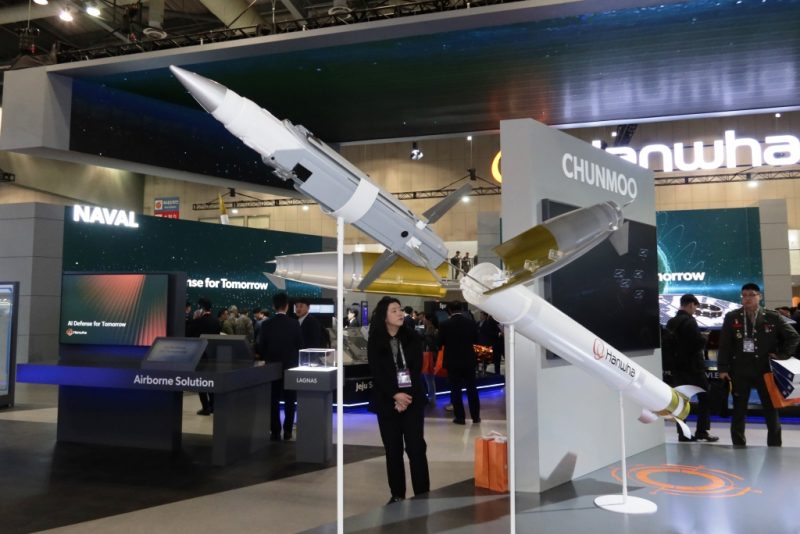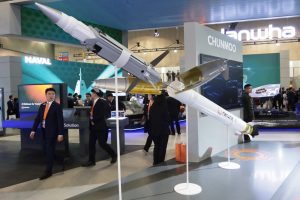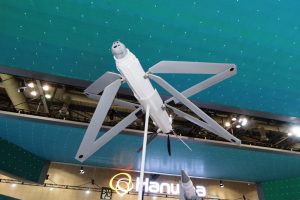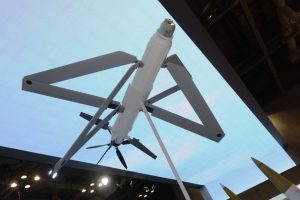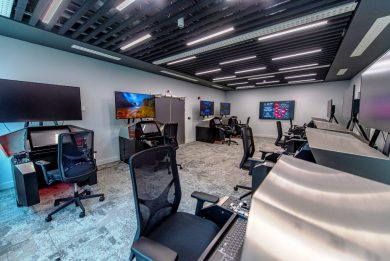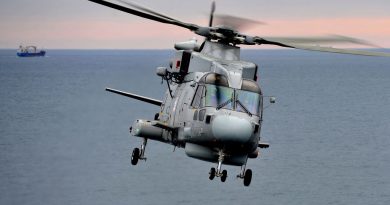ADEX 2025 – Hanwha Aerospace LPGW100 gives Chunmoo rocket launcher the capability to hit moving targets
At the Seoul defence exhibition Hanwha Aerospace showcased for the first time the LPGW100, which is deployed by a rocket and once released flies towards the target, its EO/IR sensor package providing accurate guidance in the last phase, allowing it to hit the intended target even if this is on the move
By putting together a CGR-80 rocket together with the newly designed loitering munition, Hanwha Aerospace aims at further widening the multiple rocket launcher capabilities, adding that of hitting moving targets with accuracy.
The CGR-80 is a 239 mm calibre GNSS/INS guided rocket that can hit targets between 30 and 80 km, and is fitted with a high explosive penetration fragmentation warhead. It is launched from a six-tube pod installed on the multi-calibre multiple rocket launcher, which second pod can be fitted with rockets of different type and calibre.
Once the target is identified the rocket is launched in the usual way, grids provided to the guidance system ensuring it will head with accuracy towards the target. In the new version however a further data is provided, the time at which the rocket will release the LPGW100 loitering munition. At that moment the forward part of the rocket will open, the two clamps slowing down the rocket due to the increased drag, which will allow the munition that maintains its kinetic energy to fly forward, deploy its wings and activate the propeller.
The LPGW100 has a cruciform wing configuration where wings do not have a 90° angle between each of them but around 120°/60°, each wing being made of two semi-wings hinged at the extremity that deploy once the loitering munition leaves the rocket. The rear cruciform empennage features moving straight rudders, propulsion being provided by an electric engine activating a four-blade propeller. At the front we find the electro-optic sensor package installed on a gimbal, which is initially protected by an aerodynamic cap to avoid being damaged when the munition leaves the rocket and, quite probably, to increase the range, the gimbal aerodynamic coefficient being certainly worst than that of the cap itself. In that first phase the LPGW100 will be guided by its own GNSS/INS navigation suite, the satellite guidance system being fitted with an anti-jamming/anti-spoofing system. When the cap is jettisoned the optronic system comes into play, staring to compare the over flown territory with images loaded in its memory prior to the flight, thus providing image-based navigation (IBN). EDR On-Line understood that in the final attack phase the EO/IR suite becomes the system of choice for guiding the munition with utmost accuracy on the target, either static or moving.
The munition is fitted with a SATCOM data-link that allows re-programming the system in flight, should target data change. Designed to deal with armoured targets, the LPGW100 is fitted with a shaped charge warhead, preformed fragments providing flexibility adding a secondary antipersonnel capacity. The warhead has a mass of 6 kg and a 150 mm diameter, the whole munition mass being around 25 kg. No dimensional data were provided.
EDR On-Line understood that the system is currently undergoing the Critical Design Review. Single components have been tested in laboratory, Hanwha Aerospace considering testing the LPGW100 as a stand-alone system in 2026, the testing of the whole system being forecasted for 2027/28. Considering the rocket maximum range and that of the electric-powered munition, the overall range of the system should be around 100 km.
It is to remember that Hanwha Aerospace and WB Group of Poland announced at MSPO 2025 that a joint venture is being created to produce the CGR-80 in Poland, where it is known as Homar-K. Full production capacity should be attained in 2028. How much the further variant unveiled at ADEX 2025 in Seoul might interest also Poland remains to be seen, but it would certainly add a key capacity to the Chunmoo rocket launchers deployed by the Polish Army.
Photos by P. Valpolini

